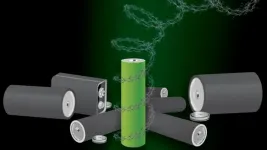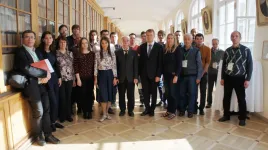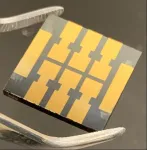In graphene process, resistance is useful
Rice lab uses laser-induced graphene process to create micron-scale patterns in photoresist
2021-05-06
(Press-News.org) HOUSTON - (May 6, 2021) - A Rice University laboratory has adapted its laser-induced graphene technique to make high-resolution, micron-scale patterns of the conductive material for consumer electronics and other applications.
Laser-induced graphene (LIG), introduced in 2014 by Rice chemist James Tour, involves burning away everything that isn't carbon from polymers or other materials, leaving the carbon atoms to reconfigure themselves into films of characteristic hexagonal graphene.
The process employs a commercial laser that "writes" graphene patterns into surfaces that to date have included wood, paper and even food.
The new iteration writes fine patterns of graphene into photoresist polymers, light-sensitive materials used in photolithography and photoengraving.
Baking the film increases its carbon content, and subsequent lasing solidifies the robust graphene pattern, after which unlased photoresist is washed away.
Details of the PR-LIG process appear in the American Chemical Society journal ACS Nano.
"This process permits the use of graphene wires and devices in a more conventional silicon-like process technology," Tour said. "It should allow a transition into mainline electronics platforms."
The Rice lab produced lines of LIG about 10 microns wide and hundreds of nanometers thick, comparable to that now achieved by more cumbersome processes that involve lasers attached to scanning electron microscopes, according to the researchers.
Achieving lines of LIG small enough for circuitry prompted the lab to optimize its process, according to graduate student Jacob Beckham, lead author of the paper.
"The breakthrough was a careful control of the process parameters," Beckham said. "Small lines of photoresist absorb laser light depending on their geometry and thickness, so optimizing the laser power and other parameters allowed us to get good conversion at very high resolution."
Because the positive photoresist is a liquid before being spun onto a substrate for lasing, it's a simple matter to dope the raw material with metals or other additives to customize it for applications, Tour said.
Potential applications include on-chip microsupercapacitors, functional nanocomposites and microfluidic arrays.
INFORMATION:
Co-authors are undergraduate John Tianci Li, alumnus Michael Stanford and graduate students Weiyin Chen, Emily McHugh, Paul Advincula, Kevin Wyss and Yieu Chyan of Rice; and alumnus Walker Boldman and Philip Rack, a professor and Leonard G. Penland Chair of Materials Science and Engineering at the University of Tennessee, Knoxville. Tour is the T.T. and W.F. Chao Chair in Chemistry as well as a professor of computer science and of materials science and nanoengineering at Rice.
The Air Force Office of Science Research, the National Science Foundation and the Department of Energy supported the research.
Read the abstract at https://pubs.acs.org/doi/10.1021/acsnano.1c01843.
This news release can be found online at https://news.rice.edu/2021/05/06/in-graphene-process-resistance-is-useful/.
Follow Rice News and Media Relations via Twitter @RiceUNews.
Related materials:
Defects are perfect in laser-induced graphene: http://news.rice.edu/2014/12/10/defects-are-perfect-in-laser-induced-graphene-2/
Tour Group: https://www.jmtour.com
Department of Chemistry: https://chemistry.rice.edu
Wiess School of Natural Sciences: https://naturalsciences.rice.edu
Images for download:
https://news-network.rice.edu/news/files/2021/04/0503_PR-LIG-1-web.jpg
A scanning electron microscope image shows a cross-section of laser-induced graphene on silicon. The graphene was created at Rice University by lasing a photoresist polymer to make micron-scale lines that could be useful for electronics and other applications. The scale bar is 5 microns. (Credit: Tour Group/Rice University)
https://news-network.rice.edu/news/files/2021/04/0503_PR-LIG-2-web.jpg
Rice University chemists have adapted their laser-induced graphene process to make conductive patterns from standard photoresist material for consumer electronics and other applications. (Credit: Tour Group/Rice University)
https://news-network.rice.edu/news/files/2021/04/0503_PR-LIG-3-web.jpg
A laser-induced graphene Rice Owl is surrounded by photoresist material at left and stands alone at right after the excess photoresist is washed away with acetone. Rice University scientists are using the process to create micron-scale lines of conductive graphene that could be useful in consumer electronics. (Credit: Tour Group/Rice University)
https://news-network.rice.edu/news/files/2021/04/0503_PR-LIG-4-web.jpg
Rice University graduate student Jacob Beckham shows a sample of photoresist laser-induced graphene, patterned in the shape of an owl. The Rice lab is making conductive patterns from standard photoresist material for consumer electronics and other applications. (Credit: Aaron Bayles/Rice University)
Located on a 300-acre forested campus in Houston, Rice University is consistently ranked among the nation's top 20 universities by U.S. News & World Report. Rice has highly respected schools of Architecture, Business, Continuing Studies, Engineering, Humanities, Music, Natural Sciences and Social Sciences and is home to the Baker Institute for Public Policy. With 3,978 undergraduates and 3,192 graduate students, Rice's undergraduate student-to-faculty ratio is just under 6-to-1. Its residential college system builds close-knit communities and lifelong friendships, just one reason why Rice is ranked No. 1 for lots of race/class interaction and No. 1 for quality of life by the Princeton Review. Rice is also rated as a best value among private universities by Kiplinger's Personal Finance.
[Attachments] See images for this press release:

ELSE PRESS RELEASES FROM THIS DATE:
2021-05-06
As the human body's largest organ, the skin is responsible for protecting against a wide range of possible infections on all fleshy surfaces, from head to toe. So how exactly does the skin organize its defenses against such an array of threats?
A new Yale study shows that the epidermis, the outermost layer of skin, is comprised of an army of immune cells that station themselves at regular intervals across the skin's vast expanse to resist infection. When necessary, the researchers found, these immune system soldiers are able to reposition themselves to protect vulnerable areas.
The study, published in the journal Nature Cell Biology, was conducted by the lab of Valentina ...
2021-05-06
The introduction of lithium-ion (Li-ion) batteries has revolutionized technology as a whole, leading to major advances in consumer goods across nearly all sectors. Battery-powered devices have become ubiquitous across the world. While the availability of technology is generally a good thing, the rapid growth has led directly to several key ethical and environmental issues surrounding the use of Li-ion batteries.
Current Li-ion batteries utilize significant amounts of cobalt, which in several well-documented international cases is mined using child labor in dangerous working ...
2021-05-06
The idea of creating quantum computers has long captured the minds of researchers and experts of IT corporations. They are the most powerful computers operating according to the laws of the quantum world and capable of solving many problems more efficiently than the most productive classical supercomputers. Similar developments are underway, for example, at Google and IBM. However, many such projects require the use of cryostats. These are vessels with liquid nitrogen or compressed helium, inside which quantum processors are cooled to temperatures below -270°C. Such a low temperature is required to maintain the superconductivity effect, which is necessary for the operation ...
2021-05-06
Today's 10,000 species of birds live in virtually every habitat on Earth, but only a handful have adaptations enabling them to hunt active prey in the dark of night. Scientists have long wondered whether theropod dinosaurs - the group that gave rise to modern birds - had similar sensory adaptations.
A new study led by University of the Witwatersrand scientist, Professor Jonah Choiniere, sought to investigate how vision and hearing abilities of dinosaurs and birds compared. The international team of researchers used CT scanning and detailed measurements to collect information ...
2021-05-06
New Haven, Conn. -- If paleontologists had a wish list, it would almost certainly include insights into two particular phenomena: how dinosaurs interacted with each other and how they began to fly.
The problem is, using fossils to deduce such behavior is a tricky business. But a new, Yale-led study offers a promising entry point -- the inner ear of an ancient reptile.
According to the study, the shape of the inner ear offers reliable signs as to whether an animal soared gracefully through the air, flew only fitfully, walked on the ground, or sometimes went swimming. In some cases, the inner ear even indicates whether ...
2021-05-06
The findings, published in the journal Science today, demonstrate how integrating vertical descent and horizontal gene transfer can be used to infer the root of the bacterial tree and the nature of the last bacterial common ancestor.
Bacteria comprise a very diverse domain of single-celled organisms that can be found almost everywhere on Earth. All Bacteria are related and derive from a common ancestral Bacterial cell. Until now, the shape of the bacterial tree of life and the placement of its root has been contested, but is necessary to shed light on the early evolution of life on our ...
2021-05-06
The uncertainty principle, first introduced by Werner Heisenberg in the late 1920's, is a fundamental concept of quantum mechanics. In the quantum world, particles like the electrons that power all electrical product can also behave like waves. As a result, particles cannot have a well-defined position and momentum simultaneously. For instance, measuring the momentum of a particle leads to a disturbance of position, and therefore the position cannot be precisely defined.
In recent research, published in Science, a team led by Prof. Mika Sillanpää at Aalto University in Finland has shown that there is a way to get around ...
2021-05-06
In the 150 years since Charles Darwin speculated that humans originated in Africa, the number of species in the human family tree has exploded, but so has the level of dispute concerning early human evolution. Fossil apes are often at the center of the debate, with some scientists dismissing their importance to the origins of the human lineage (the "hominins"), and others conferring them starring evolutionary roles. A new review out on May 7 in the journal Science looks at the major discoveries in hominin origins since Darwin's works and argues that fossil apes can inform us about essential aspects of ape and human evolution, including the nature ...
2021-05-06
PROVIDENCE, R.I. [Brown University] -- A research team from Brown University has made a major step toward improving the long-term reliability of perovskite solar cells, an emerging clean energy technology. In a study to be published on Friday, May 7 in the journal Science, the team demonstrates a "molecular glue" that keeps a key interface inside cells from degrading. The treatment dramatically increases cells' stability and reliability over time, while also improving the efficiency with which they convert sunlight into electricity.
"There have been great strides ...
2021-05-06
MUSC Hollings Cancer Center researchers added to the understanding of the protective immune response against the SARS-CoV-2 virus in a study published in April in iScience. The team found that approximately 3% of the population is asymptomatic, which means that their bodies can get rid of the virus without developing signs of illness.
The researchers screened more than 60,000 blood samples from symptomless individuals in the Southeastern U.S., including Georgia, South Carolina and North Carolina, for the IgG antibody to the viral spike protein.
What began as a highly collaborative statewide effort to detect SARS-CoV-2 accurately, ...
LAST 30 PRESS RELEASES:
[Press-News.org] In graphene process, resistance is useful
Rice lab uses laser-induced graphene process to create micron-scale patterns in photoresist








